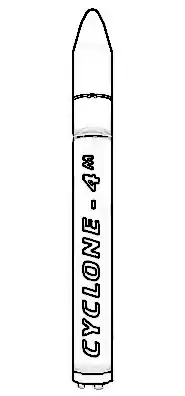Cyclone-4M
The Cyclone-4M is a Ukrainian carrier rocket which is being developed for commercial satellite launches.
 | |
| Function | Carrier rocket |
|---|---|
| Manufacturer | |
| Country of origin | Ukraine |
| Project cost | $304M (projection, $148M spaceport included)[1] |
| Cost per launch | $45M[2]-$60M[1] (projections) |
| Size | |
| Height | 38.7 m (127.0 ft)[3] |
| Diameter | 4.0 m (13 ft)[3] |
| Stages | 2 |
| Capacity | |
| Payload to 200 km LEO (45.3°) | |
| Mass | 5,000 kg (11,000 lb)[4] |
| Payload to 500 km LEO | |
| Mass | 4,600 kg (10,100 lb)[3] |
| Payload to 1200 km LEO | |
| Mass | 3,900 kg (8,600 lb)[3] |
| Payload to 500 km polar LEO | |
| Mass | 3,600 kg (7,900 lb)[3] |
| Payload to 1200 km polar LEO | |
| Mass | 3,000 kg (6,600 lb)[3] |
| Payload to 500 km SSO | |
| Mass | 3,450 kg (7,610 lb)[3] |
| Payload to 1000 km SSO | |
| Mass | 3,000 kg (6,600 lb)[3] |
| Payload to 180×35,768 km) GTO (45.2°) | |
| Mass | 910 kg (2,010 lb)[4] |
| Associated rockets | |
| Family | Zenit / Tsyklon |
| Comparable | Tsyklon-2, -3, -4, Dnepr, Soyuz-2, PSLV, Long March 4B/C |
| Launch history | |
| Status | In development |
| Launch sites | Canso, Nova Scotia, Canada[1] |
| Total launches | 0 |
| First flight | 2020 (planned)[5] |
| First stage | |
| Diameter | 3.9 m (13 ft)[3] |
| Gross mass | 260,700 kg (575,000 lb)[3] |
| Propellant mass | 224,800 kg (496,000 lb)[4] |
| Engines | 4 × RD-870 engines[4] |
| Thrust | Sea level: 3,130 kN (319 tf) Vacuum: 3,498 kN (356.7 tf)[3] |
| Specific impulse | Sea level: 298 s (2.92 km/s) Vacuum: 332 s (3.26 km/s)[6] |
| Burn time | 200 seconds[6] |
| Fuel | LOX / RP-1 |
| Second stage | |
| Diameter | 3.98 m (13.1 ft)[3] |
| Gross mass | 14,000 kg (31,000 lb)[3] |
| Propellant mass | 10,700 kg (24,000 lb)[4] |
| Engines | 1 × RD-861K |
| Thrust | 77.63 kN (7.916 tf)[3] |
| Specific impulse | 325 s (3.19 km/s) |
| Burn time | 450 seconds |
| Fuel | N 2O 4 / UDMH |
History
The Cyclone-4M is derived from the Tsyklon-4, which started its life as an all-hypergolic three-stage-to-orbit expendable launch vehicle planned for launch from a proposed site at the Alcântara Launch Center in Brazil. However, Brazil backed out of the partnership with Ukraine in 2015, citing concerns over the project budget, the ongoing financial situation in both countries, and the future of the commercial launch market.[7] In March 2017, Canadian company Maritime Launch Services announced plans to begin launching a modified version, the Cyclone-4M, which features a Zenit-derived kerolox (LOX / RP-1) first stage in place of the originally planned R-36 ICBM-based first- and second-stage.
Design
This new first-stage design would use four kerolox engines derived from the RD-120 used on the second stage of the Zenit. The standard RD-120, however, while manufactured in Ukraine, uses a number of Russian-made components which would have to be replaced with Ukrainian-made equivalents. It is also planned to fit each of these engines with a gimballing mechanism for steering (in the Zenit second stage the RD-120 is fixed to the frame while an RD-8 four-nozzle vernier engine takes care of the steering).[4]
Cyclone-4M is planned for launch from a site in Canso, Nova Scotia, with construction beginning in 2018.[8][1][5] The second stage completed qualification tests in October 2019.[9] The rocket's maiden flight is planned for late 2021.[9] It's planned to launch up to 8 rockets per year from 2022.[10][11]
References
- Ruskin, Brett; Williams, Cassie (14 March 2017). "T-minus 1 year until rocket launch site construction starts in Nova Scotia". CBC News. Retrieved 18 March 2017.
- "About". Maritime Launch Services. Retrieved 15 October 2017.
Cyclone 4M will be available for $45M USD per launch.
- "Cyclone-4M". Yuzhnoye Design Office. Archived from the original on 2018-07-04. Retrieved 15 October 2017.
- Zak, Anatoly (19 March 2017). "Tsyklon-4M (Cyclone-4M) prepares a move to Canada". RussianSpaceWeb. Retrieved 22 March 2017.
- Boucher, Marc (14 March 2017). "Exclusive: Maritime Launch Services Selects Nova Scotia Site for Spaceport Over 13 Other Locations". SpaceQ. Retrieved 18 March 2017.
- Zak, Anatoly. "RD-870 could become Ukraine's first booster engine". RussianSpaceWeb. Retrieved 15 October 2017.
- de Selding, Peter B. (16 April 2015). "Brazil Pulling Out of Ukrainian Cyclone-4 Launcher Project". Space News. Retrieved 9 April 2016.
- Doucette, Keith (14 March 2017). "Small Nova Scotia fishing community picked as launch site for rockets". TheStar.com. The Canadian Press. Retrieved 15 October 2017.
- "Cyclone 4M fully integrated upper stage performs successful qualification test" (Press release). Yuzhnoye Design Office and Maritime Launch Services. 21 October 2019. Retrieved 1 December 2019.
- "Le Canada ouvrira sa première base de lancement spatiale d'ici 2020". France 24 (in French). 2017-03-20. Retrieved 2020-06-03.
- "T-minus 1 year until rocket launch site construction starts in Nova Scotia". 14 March 2017. Retrieved 3 June 2020.
